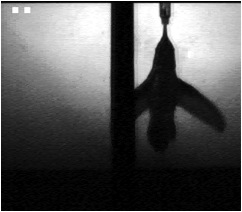This is an analysis I did during my undergraduate days. Unfortunately this is the best pictures I have. The first picture shows the shadow of a bird on the left and a vector field showing the movement of the air around the bird. Note that we were only catching one plane of particles at a time. These vectors are colored blue if they are pointing up and red if they are pointing down. Thus the blue portion is the upstroke part of it’s wake and the red is the downstroke. The second picture is a top view of the bird where the black line going down the middle shows the plane of particles we were capturing.
This project interested me mainly because of the technology. To be able to view the way air particles are moving and analyze it was a very impressive feat. This was also an interesting project because at the time scientists were unable to find enough force in the wake of a flying bird to show that it could actually support its weight in the air. It was unclear whether this under calculation was due to current measuring techniques, a complicated vortical structure, or wake decay. To try and solve this issue, I wrote a program that sifted through thousands of these vector fields for birds flying at different speeds to see whether the wake does decay significantly and if it is affected by Reynold’s number. We found that it did decay but it was not significantly affected by Reynold’s number at least in the short time we measured. In addition, we came up with a new method that gave enough force to support a bird’s weight when decay is taken into account.

